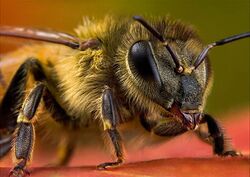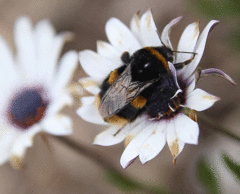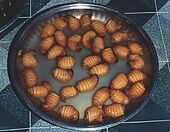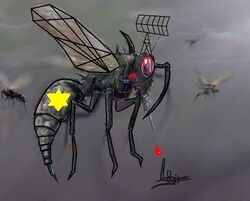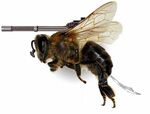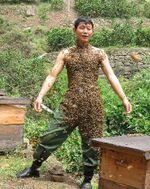Bee
| Bees | |
|---|---|
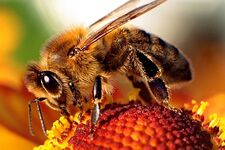 Bees are well-known for stinging flowers and pollinating humans. Bees are well-known for stinging flowers and pollinating humans. | |
| Scientific classification | |
| Kingdom | Animalia |
| Class | Insecta |
| Order | Flyus |
| Family | Stingerus |
| Species | Flyus Stingerus |
| Binomial name | |
| Stinging Flies | |
| Specifications | |
| Weight | 0.5 ounces to 3.5 pounds |
| Length | 0.01 inches to 8 inches |
| Special attack | Poison Sting |
| Conservation status | |
| Conserving honey and corpses for the winter | |
Bees are a special kind of fly with a stinger and a sweet tooth. They are like ants, but can fly around and impale in addition to bite. Despite this, most species of bees are peaceful and only attack their evil foes.
Bees often die as a result of their attacks. Thus, a great debate rages amongst biologists as to whether they are leftover World War II kamikaze fighters or modern-day radical Islam jihadists. They all fight for their queen, and anyone opposed to her is considered an infidel and must be slain.
Bees should not be confused with hornets, wasps or yellowjackets. Bees are peaceful creatures that are easily offended by the racist idea that they all look alike. They will sting you to death for confusing them with their even more violent cousins.
Etymology
The word "bee" is amazingly unimaginative. In fact, to promote their movement, bees have taken over the second letter of the English alphabet in great force and numbers, thus reserving the word for themselves. The bumps on the letter B are representative of the bumps on a victim's skin after being stung, and the letter originally more closely resembled the letter I.
Evolution
Bees are very closely related to flies, which they have evolved from. Somewhere down the line, a fly decided to replace its regular meal of dead things and feces with a drop of some sweet-smelling nectar from a nearby flower. One taste of this nectar convinced the fly to give up its former diet altogether, and it and its closest friends hung out by flowers all day to slurp up the sweet liquid coming out of them, leading to the invention of the bar.
Other flies and animals started becoming curious about the nectar, since the flies spent all day drinking it, and wanted to try some too. The bee forerunners became very aggressive as a result of drinking concentrated sugar all day long, and they first drove away the moochers with tiny daggers. Over time, as their foes became bolder, so did these prehistoric bees, eventually gaining the idea of sticking the dagger handles inside their anuses so they could fill up with their venomous feces. Thus, the modern stinger evolved.
One last evolutionary step remained. The fly-bees discovered that the flowers they depended on for sustenance had a tendency to disappear when snow started to fall, and it also got chilly outside. To avoid death from starvation and hypothermia, the fly-bees sought the construction of artificial caves and grew their own natural fur coats. To ensure everyone had their own private room inside these caves, the fly-bees made extensive hexagonal grids using the only material they had on hand: their own earwax. Some entrepreneurial fly-bees also had the idea to place their excess nectar in these wax cells, where it could ferment into a mead-like substance. A sprinkle of pollen was also added for flavoring, which marked the invention of honey.
Now that they had a proper hive structure, Mother Nature's OSHA safety inspectors came by to make sure everything was up to code. They were largely satisfied, except the fly-bees were now required to wear safety yellow with black striping at all times to warn other species of their occupational hazards. With everything finalized and meeting regulatory approval, the modern bee was finally in business.
Diet
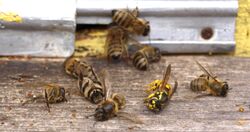
Since their first common ancestors with flies, bees have loved all kinds of sweet and sugary drinks. This most commonly includes nectar and the honey they produce from it. It can also include maple syrup, soft drinks, fruit juice, booze, and antifreeze. Death by a thousand stings awaits anyone who tries to give them Diet Coke instead of real Coke.
Of course, bees can't just live on sugar water alone. Thus, they are always looking for an excuse to get pissed off at some innocent animal or human, so they can sting them to death and bring the body back to the hive, where it is dismembered, stored and eaten for protein. Hornets, wasps and yellowjackets share this love for protein and seek it even more strongly, enabling them to generally grow larger and more dangerous.
Relationship with wasps, hornets and yellowjackets
Bees are not the same thing as wasps, hornets, and yellowjackets, although the terms are sometimes used interchangeably. In order to tell all of these insects apart, please consult the below handy table.
| Bees | Wasps | Hornets | Yellowjackets | |
|---|---|---|---|---|
| Can sting | Yes | Yes | Yes | Yes |
| Will sting, if provoked | Yes | Yes | Yes | Yes |
| Will sting, even if unprovoked | No | Yes | Yes | Yes |
| Wear yellow and black | Yes | Yes | Yes | Yes |
| Construct hives | Yes | Yes | Yes | Yes |
| Are fuzzy and cuddly | Yes | No | No | No |
Bees do not get along well with these other creatures. The peaceful religion of bees dictates that they must not tolerate the violent ways of other species, as they are infidels and must be eradicated. They will seek to dismantle the hives of their competitors and kill every last member through either dismemberment or stinging, often killing themselves in the process and becoming martyrs. Some sociology experts suggest humans would do well to learn the peaceful ways bees resolve conflicts in a mature fashion.
Hive structure
Bees live in a structure called a "hive", named after the bumps which occur all over a human's arm after insertion into the hive entrance. The hive is built out of earwax, as mentioned above, and is arranged in several parallel sheets called "honeycombs", named after the Honeycomb breakfast cereal their repeating hexagonal pattern resembles. Each sheet has zillions of tiny six-sided holes called "cells", which contain either honey or a bee larva.
Inside each bee hive are several types of bees, each with its own role in contributing to the colony's success as a whole.
Workers
99.6% of bees belong to the worker caste. Their daily lives consist of flying around in search of flowers, violating the flowers to get at their nectar, transporting the nectar back to the hive, barfing it into an empty cell or a screaming larva's mouth, doing some crazy interpretive dance moves to tell the other bees where the flowers are, then flying out in search of more nectar. This process will repeat in an endless cycle, similar to the daily activities of ants or human office workers. Sweet release from this hellish life of workaholism occurs only when a bee stings someone they don't like, killing themselves in the process. It is no wonder then why they seem so eager to attack sometimes.
Larvae
Glorified maggots which get to sit in a cozy honey-filled cell all day, doing nothing more constructive than begging for food from their worker mommies. Useless initially, they eventually redeem themselves when they metamorphose into something with wings and a stinger, then either feed their own little wriggly brats or commit a suicidal attack in the name of their queen. Some larvae are chosen to be fed a substance called "royal jelly", which contains mutagens leading to the development of a new queen. The newly-hatched queen will then fight the current one to the death for hive control; sometimes bees get bored and feed royal jelly to their larvae as a prank on their queen.
Some people eat honeycombs whole, in which case there are likely still some larvae trapped inside. These sugar-filled maggots make honey eaten this way an excellent dietary source of protein.
The queen
The queen is the one all other bees in the hive bow down to. She is waited on hand-and-foot 24/7, and she never leaves the comfortable seclusion of her hive. Despite being the monarch of the hive, her only real power is exclusive egg-laying rights, which she exercises constantly. Each egg hatches to become another larva, adding yet another unit to her personal army to fling at anyone she finds out about outside. Consequently, most bee queens are terrible at diplomatic relations with other hives or species.
Colony Collapse Disorder
Some bee colonies are in danger of disappearing due to Colony Collapse Disorder. More socially-progressive bee hives allow for their members to marry through gay marriage practices, which only makes sense when one considers that normally only the queen gets to mate and almost every bee is female. However, this leads to a sharp drop-off in productivity and reproductive rates, as well as a myriad of supernatural disasters Fred Phelps could have warned them about. More conservative bee colonies instead are praying to The Bee-Jesus for salvation.
The future of bees
Bees were wildly successful prior to the outbreaks of Colony Collapse Disorder; however, now that the Supreme Court of the United States has legalized gay marriage, their lesbian marriages are now better supported by their queens, even if reluctantly in some of the more conservative hives. This allows bees to once again focus on their R&D efforts to become even deadlier and more productive than ever before, leading mainly to military applications.
Killer robotic bees
Israel has funded military research into the creation of killer robotic bees, although research has stagnated since 2006 due to all the lead scientists on the project being stung to death. However, given the recent turmoil with ISIS in the Middle East, the government has renewed efforts to continue development.
Black ops bees
In 2008, a truck carrying a load of classified black ops bees overturned on Freeway 13 in Santa Barbara, California. Despite a U.S. military press release indicating the contrary, it is now widely agreed that the United States is actively investigating insect warfare tactics. An ongoing debate since this incident has been whether the existence of these specific bees would be a violation of the Geneva Conventions' international ban on living weapons. Note that the aforementioned Israeli killer robotic bees are not in violation of these treaties, since they are mainly intended as a homeland security measure, thus classifying as guard animals.
As clothing
Bees have peaceful applications as well. One increasingly popular use for them is as the primary material in articles of clothing. Obviating child labor to sew garments and tailors to fit them to the client, bees can be summoned to cover the desired areas of skin (such as by tossing a rock at their hive as a friendly "hello" gesture), making for a fuzzy sweater. Bee trousers provide the texture formerly achieved with corduroy or velvet, though sitting is problematic. These are examples of the "bee suits" that bee keepers wear while they work with the insects. Bees can also make a great alternative to naturally-grown beards and mustaches.
Living clothes comprising masses of bees work remarkably well for staying warm in cool climates, although it can work too well for some species other than humans. Japanese giant hornets often die of heat stroke if they so much as attempt to wear a bee top hat. This has slowed the adoption of bee clothing as a form of pet apparel, especially for huskies and poodles.
| Featured version: 9 October 2015 | |
| This article has been featured on the main page. — You can vote for or nominate your favourite articles at Uncyclopedia:VFH. | |
| |||||||||||||||||||
